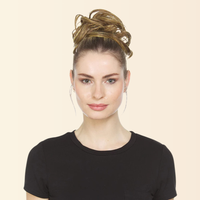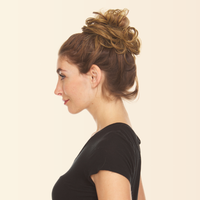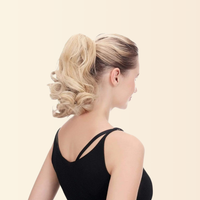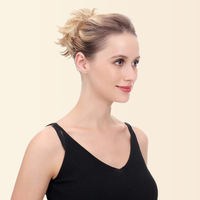
Unique features of appearance are given by genes, which a person inherits from his ancestors. Hair is clear proof of this. The function of the hair is protection. They prevent the negative effects of UV radiation, cold, dust, humid and dry climates.
Each person's appearance is unique. However, all are subject to certain standards and fall within the designated framework.
Different natural hair types. Human hair is also subject to classification. It is divided according to numerous characteristics, including race, color type, and even how quickly the head gets dirty.
You need to determine your hair type to find the right care. What’s my hair type? The hair structure is the same for everyone, but the color and properties are very individual. Lifestyle and grooming habits have an impact, but it mostly depends on genetics. There are three main hair types: normal, oily, and dry, and one additional combination.
Table of Contents
Normal Hair Type
Seeing thick, well-groomed hair in advertising cosmetics, girls mistakenly conclude that this is the only way normal hair should look. But given that there are thin, fluffy, heavy, and all hair types, normal hair has a healthy look and proper functioning of the sebaceous glands.
Hair with a healthy shine, does not get tangled when combing, does not electrify, is easy to style, and does not require frequent washing. Straight, thin, wavy, normal hair of any color will shine in the sun and keep its shape.
Normal hair care. Normal hair should be washed 1-2 times a week. Care products should be chosen only for your hair type not to upset the pH balance. It is recommended to use balms and conditioners for additional nutrition and protection of hair from the external environment. Fortified masks with natural ingredients and massage will only improve the condition and accelerate hair growth.
Oily Hair Type
Owners of oily hair will agree that cleaning up the scalp with frequent washing turns into a vicious circle. The more often you wash your hair, the faster the scalp tries to restore its usual balance with the increased productivity of the sebaceous glands.
If one wash a day is enough to keep your hair looking normal until the evening, then you can put up with daily washing. But if after a couple of hours the hair looks like after a week in the desert under the sun, then this is, of course, torture. Some people prefer to tie their hair in a ponytail, do short haircuts, or partially wash their hair, but it is still better to solve the problem with other methods.
If the type of hair has changed at a certain period, then this may be due to a hormonal imbalance or an incorrect lifestyle, so first, you need to change the diet and check the general condition of the body. Different natural hair types need different care.
Oily hair care. you should protect a scalp prone to excessive sebum production from washing with too hot water. A warm shower with shampoo for oily hair is enough to cleanse. Balms should also be used for oily hair, as they have a lighter structure, do not weigh down, and do not leave an extra layer at the roots.
To prolong the state of cleanliness of the hair, you can take as a rule of rinsing after washing, alternating a weak concentration of soda or citric acid in water. Soda and acid are sorbent for sebum residues and make hair lighter. At least once a week, you need to peel the scalp with unique products or ordinary salt.
During the peeling, microparticles of salt or cosmetic properties effectively remove sebum, prevent clogging of pores and inflammation of hair follicles. An additional effect of peeling is massage, increased blood flow, and improved microcirculation. Oily hair, like any other, requires nutrition. It is recommended to prefer herbal decoctions, fruit, and berry gruel to masks with a rich composition and dense structure.

Dry Hair Type
All hair types consist of only 3% moisture and trace elements, and the remaining 97% is keratin. Therefore, it is not difficult to imagine how important it is to maintain a natural balance. Any chemical procedures, lack of vitamins, stress, and improper lifestyle immediately affect the condition of all hair types.
Dry and brittle hair structure with split ends combined with scalp prone to dandruff, tightening and itching is quite difficult to care for. If the hair has become dry due to cosmetic experiments, it is better to begin with a course of treatment to restore the structure. With a genetic tendency to dry type, you need to choose the right care regimen, and your hair will look healthy and vibrant.
Dry hair care. It is difficult to recommend a schedule for washing your hair according to the degree of getting dirty, but not more often than two times a week. It is better to wash it with warm water, using products without aggressive components.
Shampoos, masks, and conditioners for dry hair are specially formulated to soften the skin and replenish the natural moisture in the hair. It is advisable to use leave-in caring mousses periodically, creams, and foams to fill in damaged scales and split ends; the hair will be smoother and not tangle when combing.
Decoctions of herbs and masks with natural oils must be done at least two times a month; this will eliminate irritation on the skin and prevent inflammation. Vitamin complexes will strengthen the follicles and improve the condition of the hair along the entire length. It is also advisable to use styling products without silicone with a light texture; then, the hairstyle will look natural for a long time.
Combination Hair Type
With improper care, different natural hair types can gradually become combined and cause trouble for the owner. The increased work of the scalp’s sebaceous glands in combination with dry and brittle hair requires complex daily care.
Trying to remove excess oil from the roots with deep cleaners can dry out and deplete your hair. Conversely, various nutrients with a dense structure can restore healthy-looking hair but clog the pores at the roots, weaken the follicles and slow down hair growth.
Combination hair care. Combination hair requires mixed care. Having picked up your optimal set of products, you will forget about the lack of volume at the roots and fragility of the tips. When washing your hair, you need to apply shampoo to the roots, carefully massaging the scalp without foaming the product on the hair along the entire length.
After cleansing, it is recommended to apply protective emulsions to the ends, especially with the subsequent use of a hairdryer or iron. With special masks and peels, it is necessary to carry out regular deep cleansing of the scalp while applying nourishing masks to the hair.
If possible, dispense with the use of a hairdryer, which provokes the acceleration of sebum secretion with hot air. To create styling for a long time, you can use curling irons for the root volume. Periodic rinsing of hair with decoctions of herbs and massages will normalize the skin condition and improve the condition of the hair.
Dyed Hair Type
Dyeing hair with ammonia dyes provides a change for different natural hair types by bleaching the natural pigment and filling it with a dye composition. The paint composition contains a full range of oils and trace elements, which allow minimizing the negative effects of a chemical procedure, but their effect is temporary. All hair types after dyeing require more gentle care and constant nutrition.
Colored hair care. When choosing products for the care of colored hair, it is necessary to objectively assess the condition and consider the type of hair and the effect of the procedure. A change in color for several tones or a perm quite strongly disrupts the hair’s natural structure.
It is necessary to apply special nutritious cosmetics with accumulative properties to fill and smooth the damaged scales. As far as a serious cosmetic procedure has been carried out, the hair requires gentle care. You can use ready-made cosmetics or consider your hair’s characteristics, combine oils, assets, and vitamins.
Haircare must be combined with nourishing the follicles to strengthen them and improve hair growth. If possible, subsequent dyeing exposes the regrown hair at the roots without affecting the previously dyed hair. If you want constant experimentation in finding the perfect color, it is better to contact a specialist to keep your hair easier than to grow it again.

Hair Problems And Solutions
Different natural hair types, like any organ of the body, require individual care. Due to various reasons, diseases can occur, and you need to know their main differences and solutions.
The main scalp problems are infectious, dermatological, or fungal. Fungal and infectious diseases occur with inflammation, redness, destruction of follicles, and hair loss. Dermatological conditions such as dandruff or psoriasis cause build-up on the skin.
At the slightest suspicion of a violation of the condition of the scalp, itching, or foci of inflammation, you should contact a professional trichologist. Self-medication can only aggravate the situation and lead to irreversible consequences.
A change in the hormonal background can quite strongly affect the state of all hair types; after pregnancy or menopause, the hair can begin to curl or straighten. Stress or illness can cause hair to stop growing or fall out.
In any of these situations, it is necessary to determine the cause, take care of the whole organism’s proper functioning, and provide comprehensive nutrition to the scalp in combination with massage.
Preventive measures for hair and scalp care:
- First of all, in any process, be guided by a sense of proportion; unnecessary procedures can harm.
- You must drink at least 1.5 liters of water per day, excluding juice, tea, or coffee, to prevent dandruff and dry scalp. Moisturize the scalp with light cosmetics that prevent the appearance of tightness or itching of the skin.
- If there are no contraindications, you can stimulate hair growth by combining peeling and nutrition with vitamin formulations. Salt or other peelings will cleanse the skin at the hair roots from oil and cosmetic residues, increase blood circulation and open the pores for micronutrients.
- Avoid injury to the skin, temperature changes, and unnecessary washing of hair. Keep your entire body working properly by taking vitamins during the off-season to prevent stress. Living the proper lifestyle will be another significant contribution to the health of your hair.
Once you have found the answer to the question what's my hair type, you need to choose the most appropriate care for the health of your hair and scalp.
We can help you to make your hair be more healthy and maintain natural balance. Learn more in JuvaBun!
Read also: How To Establish The Proper Hair Care Routine









Leave a comment
This site is protected by hCaptcha and the hCaptcha Privacy Policy and Terms of Service apply.